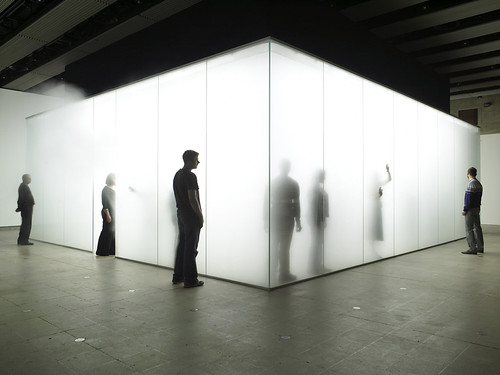September 5th was the opening of
Olafur Eliasson’s mid-career survey at the
San Francisco Museum of Modern Art, and I wasn’t there, mostly because I couldn’t bear to leave my little corner of Berkshire heaven. I’m not ready for the art world season to start, not just yet. God was, and is, rewarding us with the most fabulous weather and I’m convinced no art or art-related event could match the perfection of an early evening dip in the cool and tranquil Green River. Besides,
Einar and
Manuela came here on their way back to Iceland and then Berlin, with a full report.
Olafur, I predict, is on his way to establishing himself as a household name, and when the show travels to the
Museum of Modern Art and
P.S. 1 in April, and later the
Dallas Museum of Art, I’ll be curious to see how he handles the media blitz that’s sure to follow. Up until now, he’s managed to remain aloof and keep the emphasis focused on the art—with the exception of Cynthia Zarin’s profile in
The New Yorker (November 13, 2006--not yet available online).
Zarin is a
New Yorker staff writer, and it seemed as if she didn’t have a sufficient art background and did little research, depending almost entirely on her interviews for information. A friend’s comment was “When you’re an expert, you always find something wrong” but I disagree. I mean, this is
The New Yorker, which I expect to query the experts or, at the very least, read what’s been written about the subject. Because I thought of
The New Yorker as a standard, discovering that it was fallible was a crisis of faith, like that moment in childhood when you first discover your parents could be wrong. The worst part was that this jumble of mis-emphasis and misinformation was held together with a gloss of the sharp and engaging writing for which
The New Yorker is justly renowned, but which I now see as simply style. For instance Zarin absolutely nailed it when she described Olafur as having, “the slightly crumpled look of a shop teacher at a progressive school” but treated the work itself as nothing more than a by-product of his personality.
This was the gist of my letter to the magazine, which was not published:
To the editor:
Because I feel the magazine and its readers are capable of looking at issues in depth, I was sorry that the profile by Cynthia Zarin about the artist Olafur Eliasson concentrated on his personality and process rather than the art and the philosophy behind it—and without sufficient description of the art, you have no idea why such attention is being given to it. It is especially necessary in the case of Eliasson’s work because, since most of his work is temporary and not reproducible, the number of people who have actually seen it is small.
Zarin mentions Eliasson’s relationship to the artists “Robert Irwin and James Turrell and the idea of ‘seeing yourself seeing’” but does not explain this concept or describe how it plays out in the actual work. Later she notes that Eliasson was “deeply affected by the work of the phenomenologist philosophers, especially Edmund Husserl—with their emphasis on the individual experience of reality—and by Lawrence Wechsler’s biography of Robert Irwin, Seeing is Forgetting the Name of the Thing One Sees
—without going into any greater detail or telling us what it was about the Wechsler book that so affected Eliasson. The questions Eliasson is seen asking himself are presented more as musings than essential to an overarching philosophical inquiry.
In discussing Eliasson’s Weather Project at the Tate Modern, Zarin does not mention how, in the wake of its extraordinary success, the Tate wanted to extend its run and Eliasson refused—an act that, given the artist’s consuming interest in the context of art, including that which comes before and after its installation—can be considered as much a part of the piece as its mist, mirrors, and light.
Zarin makes a case for differentiating Eliasson from his predecessors Irwin and Turrell by stating that, “Like them, he is interested in light, to which he adds a preoccupation with what he calls ‘the intersection of nature, science, and human perception.’” She goes on to say that “unlike those artists, who tend to draw the viewer’s attention to natural phenomena—Turrell’s ‘sky spaces, for example, showcase the open sky—Eliasson consistently uses mechanical artifice to create his effects….” This is absolutely not true. The work of Irwin and Turrell pioneered this “intersection of nature, science, and human perception,” making it possible for Eliasson to expand upon it, which Eliasson fully acknowledges. Further, Irwin and Turrell have done plenty of work using only mechanical means (the effect of light on scrim, to name just one example), just as Eliasson is equally involved in working with natural phenomena—as seen in a later paragraph where he says, “I want to plant flowering trees around the pool. For one week in May the petals will drop and cover the water.”
In an art world short on meaningful dialogue, where personality and process often masquerade as art, the subject of Olafur Eliasson and his work offers a unique opportunity to marry the personal with the profound and present a significant discussion on the nature of art. Since I’m sure it will be a long while before Eliasson’s work is again discussed so thoroughly in these pages, I regret that the opportunity was missed.
Sincerely,
Carol Diehl
How can you write about
Robert Irwin and not be aware of his scrim pieces? Or, for that matter, about Eliasson and not know he'd turned rivers green? I could have gone on, to comment on how Zarin says, “Eliasson invites comparison to
Buckminster Fuller, with whom he shares an interest in the aesthetics and the utility of mathematic forms,” without saying where this influence comes from: his collaboration with Einar Thorsteinn, who was Fuller’s protégé. Although the stamp of Einar’s geometry is visible throughout Olafur’s work and they frequently share exhibition credit, Einar was not available for an interview when Zarin visited the studio...so he goes unmentioned? Not that Einar minded; he often says he likes “being famous for not being famous.” But it skews the picture to leave him out of an article that’s almost entirely about Olafur’s collaborative process.

There’s more but I’ll stop. If the article had been written by
Calvin Tomkins (author of
Duchamp, one of the best art biographies ever) or
Peter Schjeldahl (who doesn’t write profiles, but if he did…) I’d be jealous. But that’s how I want to feel when I read
The New Yorker.
There. At least I’ve gotten this one off my chest, where it’s been sitting since November. Too bad I didn’t have a blog then, so I could have responded in the moment. And to read a spot-on critique of another
New Yorker article (on Paul McCartney, who seems to be showing up in all of my posts, and I haven’t even heard his new album), along with a riveting exchange with its author, go to
http://restrictedview.blogspot.com/2007/06/you-wont-see-me.html.










.jpg)







.jpg)























